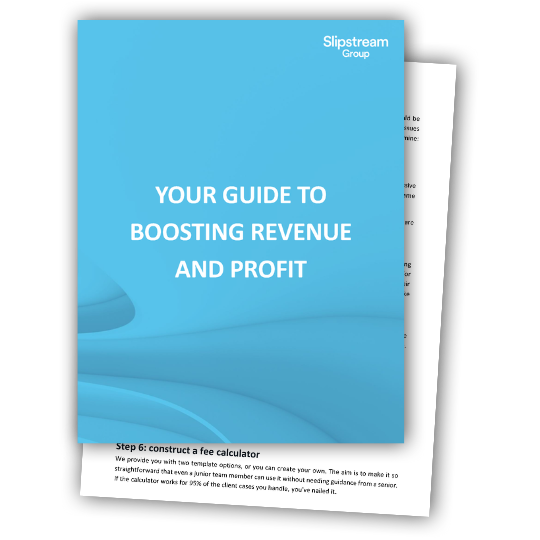Communicate your value by improving pricing and working with fewer, more ideal clients.

Work smarter, not harder. It's the secret sauce that makes Slipstream Group’s Project Uplift™ a winner for achieving true business growth. The trademarked process teaches accountants and financial planners to communicate their value by improving pricing and working with fewer, more ideal clients.
Slipstream Group is a team of people who love to help accountants and financial planners. The business coaches on their team have all owned, operated, and successfully exited their own accounting and/or financial planning firms.
Getting personal and giving advice is what Slipstream Group does. In this blog, you'll learn:
- What are PITA clients?
- What are the four ways to grow revenue?
- What is Project Uplift™?
What are PITA clients?
PITA is a creative acronym for describing less than optimal clients. If you’re new to this term, you can school yourself by visiting the Urban Dictionary for a quick overview. These are the kinds of clients you want to avoid or offload quickly if you already have them, advises Slipstream Group CEO and Co-Founder Sharon McClafferty. “Here’s my word on PITA clients,” she said. “It’s your client base. You get to decide who is in and who is out. Life is too short to work with clients you don’t enjoy.”
What are the 4 ways to grow revenue?
Growing revenue can be a tricky thing. If you Google the topic, the search engine generates listicle-style content pieces that describe all imaginable ways. McClafferty believes when it comes to financial planning and accounting, there are only four reliable ways to grow revenue:
- New clients
- New services for existing clients
- Increased prices for existing services and clients
- Mergers and acquisitions (which is just a strategy to achieve one and possibly two)
“People often ignore pricing as a way to grow their revenue,” said McClafferty. “Pricing, yes, will increase revenue. Arguably, it’ll increase cash, and it will likely improve the perception of your brand.”
McClafferty cited business mogul Warren Buffet to support her theory about the importance of pricing in growth. Buffet once said, “the single most important decision in evaluating a business is pricing power. If you have the power to raise prices without losing business to a competitor, you’ve got a very good business. If you need to have a prayer session before raising the price by 10%, then you’ve got a terrible business.”
What is Project Uplift™?
When Slipstream Group first launched, McClafferty said they learned a valuable lesson from their first client: the need for price increases in a business growth model. They helped their client design new prices he was happy with, wrote scripts to present the pricing model to his clients, and consulted with him to ensure things were going to plan.
One day the client stopped calling for consults. They waited a week before reaching out. Things were going so well that he told them he no longer needed to call before (and after) each client meeting because the process works so consistently. “We started rolling this repricing project out with more businesses,” said McClafferty.
What the Slipstream team noticed was big growth numbers for clients who adopted the strategy. “When we realized how well it was working, we named it and trademarked it,” she said.
Project Uplift™ has 12 steps.
More money, fewer clients.
Download the Project Uplift™ case studies.
Step 1: Undertake a Holistic Fact Find
The first step of the process determines whether a detailed review of pricing practices should be undertaken and determines the urgency of the task. When done correctly, it exposes any niggly issues that can affect the profit margin. As part of this initial exploration, Slipstream coaches also examine:
- The total number of clients
- The average revenue per client group
McClafferty warns the process is both thought-provoking and cringeworthy. “We can find massive inconsistencies, like legacy invoice practices, clients paying massive differences in price for the same services, and fees that have not been increased for a decade or more.”
The first step is designed to answer the question, “should I proceed with Project Uplift™ or are there more urgent issues to address first?”
Step 2: Undertake a Detailed Revenue Fact Find
Step 2 involves what McClafferty affectionately calls “a bloody big spreadsheet.” The process is not fun, but it is a worthwhile endeavour. It often makes sense to work within client categories.
One detailed revenue fact-find conducted with a $1.5 million accounting business discovered clients paying under $500 p.a. represented 4% of the fees and 43% of the clients. There were also a considerable number of clients paying under $2000 p.a. If this organisation had decided to exit all clients paying less than $2000 p.a. without going through the further Project Uplift™ steps, they would have reduced their client base by 68%, and their revenue would have only dropped by 12%, McClafferty said.
More digging showed that the below $2,000 per client category was where most of their write-offs sat, and they also discovered that this was an area where they were carrying internal headcount they were not happy with. “They had no idea it was that extreme,” she said. “The analysis gave them accurate data that allowed the client to make informed decisions.”
Step 3: Diagnosis: Is There a Problem?
During this step, Slipstream advises clients to deep dive to discover if there are problems that would prevent them from completing the uplift process. Clients must ask:
- Is there a profitable and consistent pricing methodology across the client base?
- To what extent is pricing inadequate, inconsistent, or arbitrary?
- How do clients currently perceive your service?
- What is your client’s appetite for further services and your desire to provide them?
The decision fatigue of not having consistent client pricing can become an obstacle to growth.
Steps 4 & 5: Fee Policy
When it comes to structuring new fees, designing the policy based on your ‘ideal client profile’ might be the easier place to start. McClafferty says this is due to many business owners experiencing a whole bunch of legacy issues when producing a new pricing structure for existing clients, and the process can become cumbersome.
The new pricing policy can be applied to new clients coming on board for testing and feedback. This helps practitioners build confidence and know that the new fee structure is right and still adding value to clients.
Slipstream Group have worked with many clients who have spent considerable time on this step. There is no right or wrong answer for how long steps 4 and 5 can take, said McClafferty.
“The answer to how long it takes is... as long as it needs to take! You don’t want to get to the end of this step and find you have cracks in your new fee structure. Take the time you need to get it right.”
Step 6: Construct a Calculator
Slipstream offers clients two templates from which to choose, or you can create your own. They encourage fee policies that are simple and applicable so even a junior administrator can use them without the assistance of a senior accountant or financial adviser.
“If the fee calculator can handle 95% of clients that cross your desk, you’ve probably nailed it,” said McClafferty.
Step 7: Apply the Fee to Existing Client Spreadsheet
McClafferty said this is by far her favourite part of Project Uplift™. Clients pull out the spreadsheet they created in step 2 and apply it to their existing client base to make it fair and reasonable. The coaches advise allowing an admin person to handle the task, so you're not tempted to exempt some clients from the process.
The goal is to get 100% of existing clients to say yes to the new fee structure. "One of our coaches has this great understanding of this point, basically until step 7 he argues that no one knows if they're going to go ahead with the project. And the coach doesn't know if they're going to go ahead with the project," said McClafferty.
Step 7 is where you find out what's at stake. Slipstream clients at this point know the number they're walking away from if they choose not to proceed. "And it's usually a bloody big number," she warns.
Some of the common excuses her team hears about why proceeding isn't the right move include:
- Increased fees may not be sustainable because the clients' service has not been delivered at a consistently adequate standard.
- The firm doesn't have the people or power to deliver the level of service that fits the fee model.
- Deficiencies in technology or systems make it likely that promises can't consistently be kept.
These are super reasonable things to consider when deciding whether to move forward with Project Uplift™. "If any of these excuses has left your lips, don't despair," McClafferty said. There are two options:
- Pause on the uplift rollout with the knowledge of how much it's costing you per month to delay. Focus on fixing the issues before moving forward.
- Proceed anyway, using the uplift revenue to correct the issues as you go.
"Either you proceed or delay, and that's fine. But let's have a plan," she said.
Step 8: Reflect Upon the Implications
Slipstream clients who choose to proceed after completing step 7 can expect some exciting things to follow. Among other things, they’ll have the increased ability to:
- Afford quality team members who bolster the firm’s ability to deliver quality services consistently.
- Boost profits.
- Improve business valuation.
- Invest in technology.
- Provide appropriate training to team members.
Step 9: Consider the Equity Issues
The sole purpose of this step in the process is to evaluate the fairness of your new fee schedule for all clients. When a firm has a two-tiered system, new clients effectively subsidise the current clients. “Are we OK with that?” McClafferty asks. “For how long are we OK with that? How sustainable is that two-tiered pricing system?”
Consistency is key, so Slipstream coaches advise clients to move toward more equitable pricing for all clients, regardless of their longevity with the business.
Step 10: Implementation
This is the step in the uplift process where you explain your new fee structure to your clients. You can decide how to schedule those meetings and which clients you should approach first. “You set the tone for the discussions,” said McClafferty. “You’ll need to prepare each client based on their needs.”
Slipstream’s coaches help with scripting for these meetings to ensure they go smoothly. They also troubleshoot during the implementation process to pinpoint any issues that can arise.
Step 11: Implementation Review
Your Slipstream coach continues to follow up after implementation. To achieve maximum effectiveness, coaches recommend reviewing the process and adjusting if necessary. Some clients have rolled Project Uplift™ out twice over a few years' because they met or exceeded their original goals and needed a refresh.
Step 12: Write Your Case Study
The Slipstream team commits to continually examining and improving its process. Coaches request that if Project Uplift™ worked well for you, write a case study outlining your success. Then, share what worked for you and what didn’t with the Slipstream Group. “We have a warehouse full of case studies now,” said McClafferty.
Grow your business with Slipstream Group
Working harder doesn’t always produce sustainable growth. Sometimes, it just leaves you, and your staff burned out. Slipstream Group helps accountants and financial advisers grow their businesses the right way. Download the Project Uplift™ case studies to learn more, and get in touch to schedule your no-obligation 90-minute consultation.

More money, fewer clients.
Download the Project Uplift™ case studies to learn more.
"*" indicates required fields
